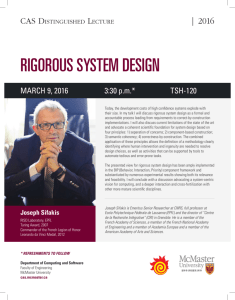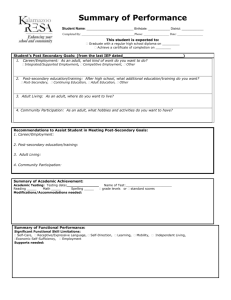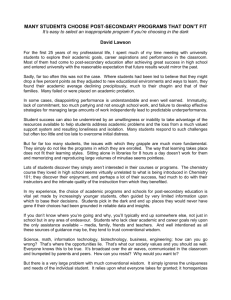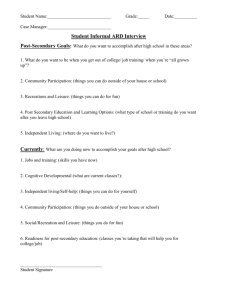(NCAC) NSOPs and Ford Next Generation Learning Essential
advertisement
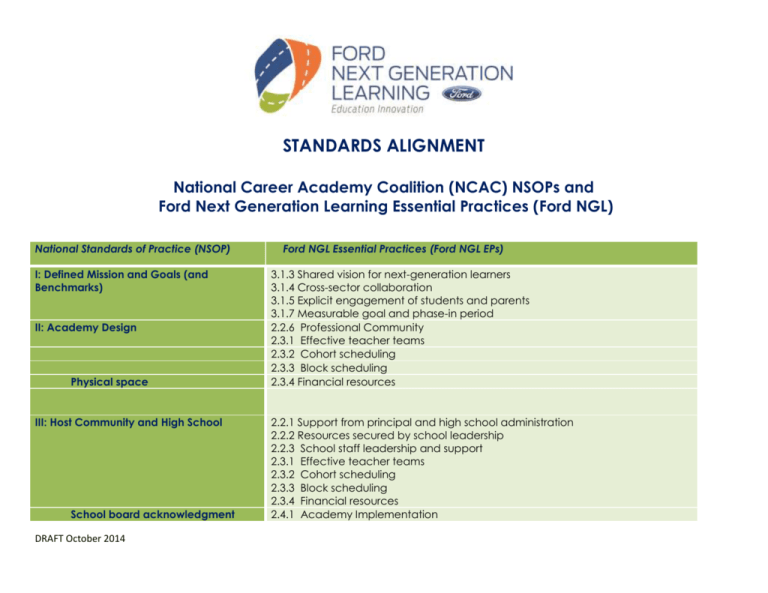
STANDARDS ALIGNMENT National Career Academy Coalition (NCAC) NSOPs and Ford Next Generation Learning Essential Practices (Ford NGL) National Standards of Practice (NSOP) I: Defined Mission and Goals (and Benchmarks) II: Academy Design Physical space III: Host Community and High School School board acknowledgment DRAFT October 2014 Ford NGL Essential Practices (Ford NGL EPs) 3.1.3 Shared vision for next-generation learners 3.1.4 Cross-sector collaboration 3.1.5 Explicit engagement of students and parents 3.1.7 Measurable goal and phase-in period 2.2.6 Professional Community 2.3.1 Effective teacher teams 2.3.2 Cohort scheduling 2.3.3 Block scheduling 2.3.4 Financial resources 2.2.1 Support from principal and high school administration 2.2.2 Resources secured by school leadership 2.2.3 School staff leadership and support 2.3.1 Effective teacher teams 2.3.2 Cohort scheduling 2.3.3 Block scheduling 2.3.4 Financial resources 2.4.1 Academy Implementation IV: Faculty and Staff 2.4.3 Data literacy for instructional improvement 2.5.1 Support and accountability from the board of education and superintendent 2.5.2 Central administration of high school transformation 2.5.3 District support for funding, facilities, equipment, and materials 2.5.4 Focused use of funding streams 1.3.7 Development of teachers’ leadership skills 2.2.3 School staff leadership and support 2.2.5 Ongoing, sustained, high-quality professional development 2.4.1 Academy implementation V: Professional Development and Continuous Learning 1.1.1 Integration of rigorous academic and career-relevant learning 1.3.1 Professional development aligned with goals for teaching and learning 1.3.2 Professional development that is grounded in research on learning and connects teachers with relevant and timely research 1.3.3 Engagement of teachers in active learning experiences that model the Teaching and Learning Pillars 1.3.4 Real-world context provided by business and community partners 1.3.5 Participation of teachers in sustained inquiry and reflection on their practice 1.3.6 Opportunities for teachers to practice and plan 1.3.7 Development of teachers’ leadership skills 2.2.4 Assessment of professional development needs, both short-and long-term 2.2.6 Professional community 2.2.7 Evaluation of professional development activities 2.3.1 Effective teacher teams 2.4.3 Data literacy for instructional improvement 3.6.3 Teacher externships VI: Governance and Leadership 3.1.5 Explicit engagement of students and parents 3.2.2 Assuring participation by mid-level managers 3.3.3 Program and curriculum review 3.4.3 Mobilizing industry support 3.4.4 Convening industry councils 3.5.2 Academic support activities that engage family members in a structured and sustained engagement process 3.8.2 School coordination with business and civic leaders DRAFT October 2014 VII: Teaching and Learning External standards VIII: Employer, Post-Secondary Education and Community Engagement DRAFT October 2014 1.1.1 Integration of rigorous academic and career-relevant learning 1.1.2 Inquiry-based 1.1.3 Project-based 1.1.4 Collaborative 1.1.5 Performance-based assessment 1.2.1 Flexible use of academic knowledge and skills 1.2.2 Problem-solving 1.2.3 Critical thinking 1.2.4 Teamwork 1.2.5 Communication 1.2.6 Creativity and innovation 1.2.7 Global awareness 2.1.1 Rigorous academic expectations that prepare students for college-level studies 2.1.2 Personalized student planning 2.1.3 Accelerated learning opportunities 2.6.1 Collaboration of postsecondary and secondary partners to promote opportunities for academy students 2.6.2 Development and promotion of post-secondary career pathways 2.6.3 Data sharing and reporting 2.6.4 Clear understanding of post-secondary requirements 2.6.5 Collaboration of post-secondary and secondary partners in building community-wide support for college going. 3.3.4 Industry standards and post-secondary opportunities 1.1.1 Integration of rigorous academic and career-relevant learning (including acquisition and application of knowledge and skills that meet rigorous state and national academic and technical standards) 1.1.1 Integration of rigorous academic and career-relevant learning 1.1.2 Inquiry-based 1.2.7 Global awareness 1.3.4 Real-world context provided by business and community partners 2.1.1 Rigorous academic expectations that prepare students for college-level studies 2.1.3 Accelerated learning opportunities 2.6.1 Collaboration of postsecondary and secondary partners to promote opportunities for academy students 2.6.2 Development and promotion of post-secondary career pathways 2.6.4 Clear understanding of post-secondary requirements 3.2.1 Active senior-level community leader participation 3.2.2 Assuring participation by mid-level managers 3.2.3 Local advocacy 3.3.1 Master plan priorities 3.3.2 Formation of industry councils 3.3.3 Program and curriculum review by employers and educators 3.3.4 Industry standards and post-secondary opportunities 3.4.3 Mobilizing industry support 3.4.4 Convening industry councils 3.6.1 Local marketing plan 3.6.2 External funding 3.6.3 Teacher externships 3.6.4 Real-world learning opportunities Citizenship 1.2.1 1.2.2 1.2.3 1.2.3 1.2.4 1.2.5 1.2.6 Flexible use of academic knowledge and skills Problem-solving Critical thinking Teamwork Communication Creativity and innovation Global awareness IX: Student Assessment 1.1.5 Performance-based assessment 2.6.3 Data sharing and reporting 3.3.3 Program and curriculum review 3.7.1 Collection of student data 3.7.3 Continual improvement 3.7.4 Participation of business and civic members of the Master Plan Partnership on academy evaluation teams 3.8.4 High expectations and measurement of improvements in college attendance and completion X: Sustainability 2.2.7 Evaluation of professional development activities 2.4.1 Academy implementation 2.4.2 Evaluation of academy effectiveness and student success DRAFT October 2014 2.4.3 Data literacy for instructional improvement 2.6.3 Data sharing and reporting 3.1 Business, civic and education leaders create a master plan for sustainable workforce competitiveness and community prosperity build on education transformation (in its entirety): 3.1.1; 3.1.2; 3.1.3; 3.1.4; 3.1.5; 3.1.6; 3.1.7; 3.1.8 3.2 Senior business, education, and civic leaders support, sustain, and advocate for the goals outlined in the master plan (in its entirety): 3.2.1, 3.2.2, 3.2.3 3.3.3 program and curriculum review 3.7.3 Continual improvement 3.7.4 Participation of business and civic members of the Master Plan Partnership on academy evaluation teams 3.7.5 Clear expectations 3.7.6 Celebration of success 3.7.7 Review of business and civic leadership effectiveness 3.8.4 High expectations and measurement of improvements in college attendance and completion DRAFT October 2014
